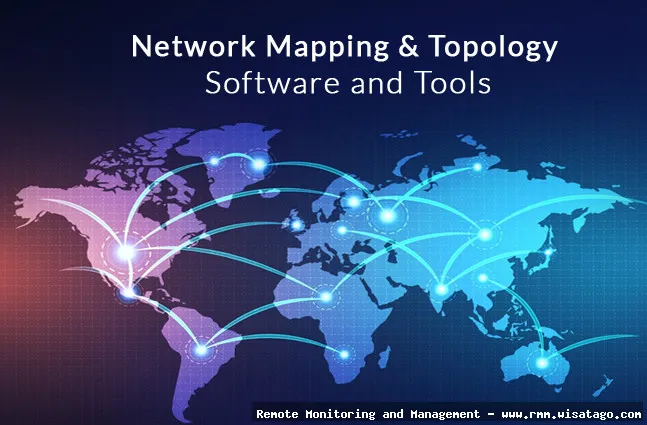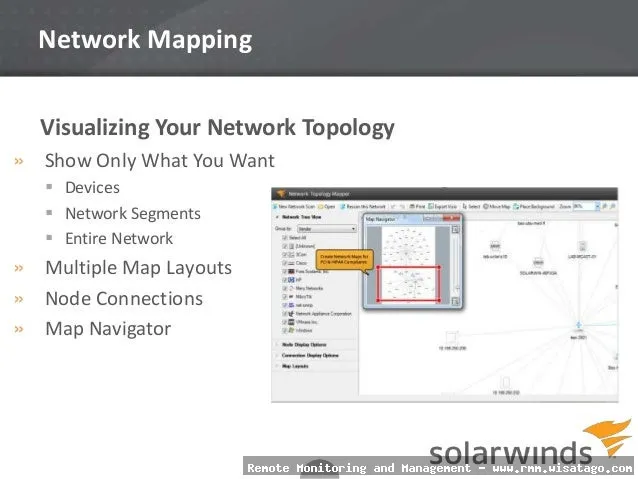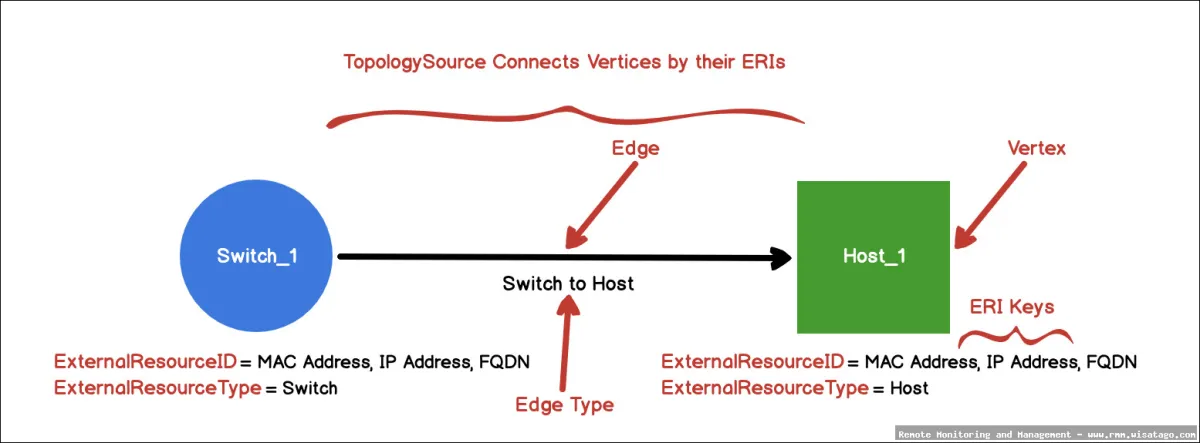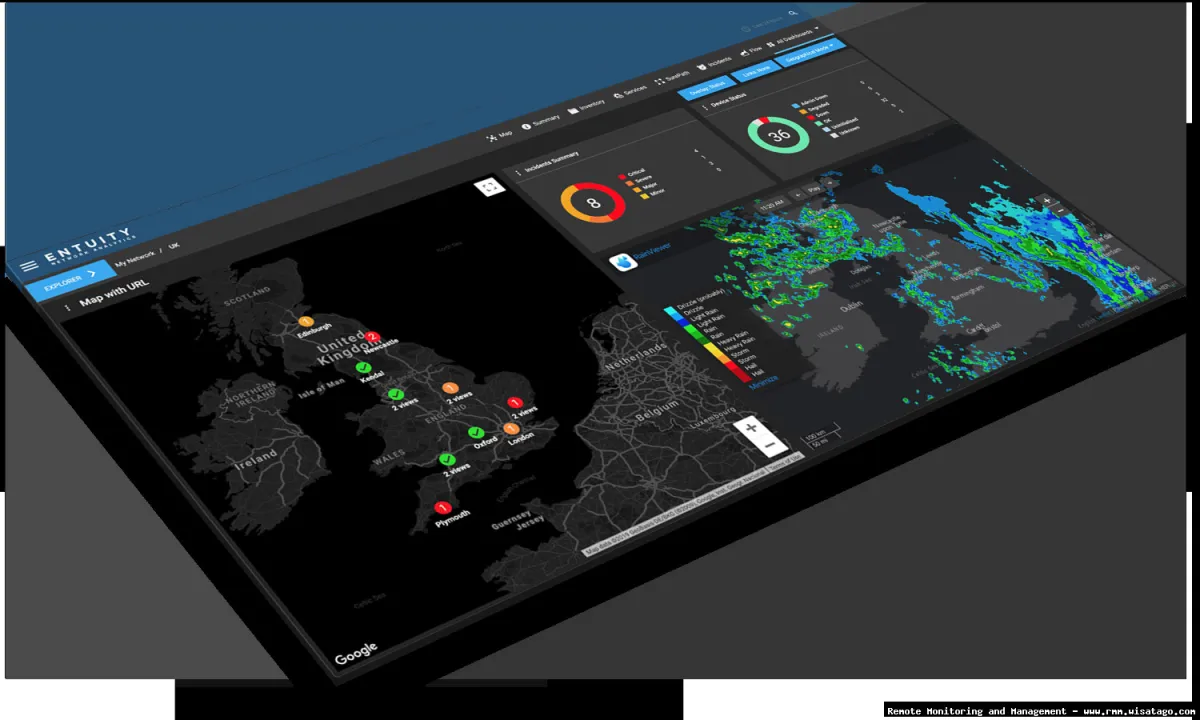In the ever-evolving landscape of IT management, staying ahead means having a clear, comprehensive view of your network. Gone are the days of manually documenting network layouts with Visio diagrams that are outdated the moment they’re printed. Today, we need dynamic, automated solutions that provide real-time insights into network infrastructure. That’s where advanced network topology mapping in Remote Monitoring and Management (RMM) platforms comes into play. It’s not just about seeing what’s connected; it’s about understanding how everything interacts and identifying potential bottlenecks before they impact your clients or your business.
Think of it this way: you’re a doctor, and your network is the patient. You wouldn’t just poke around hoping to find the problem, would you? You’d want an X-ray, an MRI, a complete picture of the inner workings. Advanced network topology mapping provides that level of detail, allowing you to diagnose issues faster, optimize performance, and proactively prevent failures. It’s a critical component for any MSP or IT department aiming to deliver top-tier service and maintain a competitive edge.

This article will delve into the world of advanced network topology mapping within RMM platforms. We’ll explore its features, benefits, and the challenges you might encounter during implementation. Whether you’re a seasoned MSP veteran or just starting to explore RMM solutions, this guide will provide a comprehensive understanding of how network topology mapping can transform your network management strategy and improve your overall IT operations.
Understanding Network Topology Mapping in RMM Platforms
Network topology mapping, at its core, is the process of visually representing the physical and logical arrangement of network devices and connections. In the context of an RMM platform, this mapping goes beyond simple device discovery. It leverages automated processes to continuously discover, analyze, and document the network infrastructure, providing a dynamic and up-to-date view of the network.
Basic vs. Advanced Topology Mapping
Most RMM platforms offer some form of network discovery, but the capabilities can vary significantly. Basic topology mapping might simply identify connected devices (servers, workstations, routers, switches) and their IP addresses. Advanced topology mapping, on the other hand, provides a more granular and insightful view, including:
- Detailed Device Information: Beyond basic identification, advanced mapping pulls in information like device make, model, operating system, firmware version, and installed software.
- Connection Types and Bandwidth: It identifies the type of connection between devices (e.g., Ethernet, Wi-Fi, Fiber) and can even estimate or measure bandwidth usage.
- Dependency Mapping: This shows how devices and applications depend on each other. For example, it can illustrate that a specific application relies on a particular server and database.
- Virtual Infrastructure Mapping: For virtualized environments, it maps virtual machines to their host servers and displays the relationships between virtual networks and physical networks.
- Cloud Infrastructure Mapping: Integrates with cloud platforms (AWS, Azure, Google Cloud) to map cloud resources and their connections to on-premises networks.
- Real-time Monitoring Integration: Displays real-time performance metrics (CPU usage, memory utilization, network traffic) directly on the topology map.
How It Works: The Discovery Process
RMM platforms use various techniques to discover and map network devices. These techniques typically involve:
- SNMP (Simple Network Management Protocol): This is a standard protocol used to monitor and manage network devices. RMM agents can query devices using SNMP to gather information about their configuration, status, and performance.
- Ping Sweeps: The RMM platform sends ICMP (ping) requests to a range of IP addresses to identify active devices on the network.
- Port Scanning: This technique probes devices for open ports to identify the services they are running.
- Network Packet Analysis: Some RMM platforms use packet sniffing to analyze network traffic and identify devices and applications.
- Agent-Based Discovery: Agents installed on devices can provide detailed information about the device’s configuration and status.
- API Integrations: Integration with cloud providers and other third-party services allows the RMM to discover and map cloud resources.
The discovered information is then processed and used to create a visual representation of the network topology. The RMM platform typically provides a user-friendly interface that allows users to navigate the map, zoom in on specific devices, and view detailed information about each device.
Key Features of Advanced Network Topology Mapping
Advanced network topology mapping is more than just a pretty picture. It’s a powerful tool that provides a wealth of information and functionality. Here are some key features to look for in an RMM platform’s topology mapping capabilities:
Automated Discovery and Updates
The best topology mapping solutions automatically discover and update the network map on a regular basis. This ensures that the map is always accurate and reflects the current state of the network. Look for features like scheduled scans, automatic device detection, and real-time updates.
Customizable Views and Filters
Every network is different, and you need to be able to customize the topology map to suit your specific needs. Look for features that allow you to filter devices by type, location, operating system, or other criteria. You should also be able to create custom views that focus on specific areas of the network or specific types of devices.

Dependency Mapping and Relationship Visualization
Understanding the relationships between devices is crucial for troubleshooting and planning. Look for features that automatically identify dependencies between devices and applications and visualize these relationships on the map. This will help you quickly identify the root cause of problems and understand the impact of changes.
Integration with Monitoring and Alerting
The topology map should be integrated with the RMM platform’s monitoring and alerting capabilities. This allows you to see the status of devices and receive alerts directly on the map. For example, if a server is experiencing high CPU usage, the map should highlight the server and display an alert icon.
Historical Data and Reporting
Advanced topology mapping solutions should also provide historical data and reporting capabilities. This allows you to track changes to the network over time and identify trends. You should be able to generate reports that show the network topology at a specific point in time or compare the topology at different points in time.
Security Vulnerability Scanning and Reporting
Some advanced RMM platforms integrate vulnerability scanning into their topology mapping. This allows you to identify potential security vulnerabilities on your network and prioritize remediation efforts. The map can highlight devices with known vulnerabilities and provide links to relevant security advisories.
Benefits of Using Advanced Network Topology Mapping
Implementing advanced network topology mapping in your RMM platform can bring significant benefits to your IT operations. These benefits extend beyond just having a visual representation of your network.
Improved Troubleshooting and Faster Resolution Times
With a clear and up-to-date topology map, you can quickly identify the root cause of network problems. The dependency mapping feature helps you understand the impact of a failure on other devices and applications. This can significantly reduce troubleshooting time and improve resolution times.
Proactive Problem Detection and Prevention
By integrating the topology map with monitoring and alerting, you can proactively identify potential problems before they impact users. For example, if a server is running out of disk space, the map can highlight the server and alert you to the issue. This allows you to take corrective action before the server crashes.
Enhanced Network Security
Topology mapping can help you identify potential security vulnerabilities on your network. By visualizing the network layout, you can easily see which devices are exposed to the internet and identify potential attack vectors. The vulnerability scanning feature can further enhance your security posture by identifying devices with known vulnerabilities.

Simplified Network Documentation and Auditing
Maintaining accurate network documentation can be a time-consuming and challenging task. Advanced topology mapping automates this process by continuously discovering and documenting the network. This simplifies network audits and ensures that your documentation is always up-to-date.
Optimized Network Performance
By visualizing network traffic and bandwidth usage on the topology map, you can identify bottlenecks and optimize network performance. You can also use the map to plan network upgrades and expansions more effectively.
Better Capacity Planning
Understanding the current state of your network and its dependencies allows for more accurate capacity planning. You can anticipate future needs and ensure you have the resources available to support growth and new initiatives. For more information, you can refer to RMM as an additional resource.
Challenges in Implementing Network Topology Mapping
While advanced network topology mapping offers numerous benefits, implementing it effectively can present some challenges.
Network Complexity
Modern networks are becoming increasingly complex, with a mix of physical and virtual devices, cloud resources, and different types of connections. Mapping these complex networks can be challenging, especially if the RMM platform’s discovery capabilities are limited.
Security Considerations
Network discovery involves scanning devices and accessing network information. This can raise security concerns if not done properly. Ensure that the RMM platform uses secure protocols and implements appropriate access controls to protect sensitive data.
Data Accuracy and Consistency
The accuracy and consistency of the topology map depend on the quality of the data collected by the RMM platform. Inaccurate or inconsistent data can lead to misleading results and incorrect decisions. It’s important to regularly verify the accuracy of the map and address any data quality issues.
Integration with Existing Systems
Integrating the RMM platform with existing systems, such as ticketing systems and asset management databases, can be challenging. Ensure that the RMM platform provides APIs and other integration mechanisms to facilitate data exchange and workflow automation.

Overwhelming Data
The sheer volume of data collected by advanced topology mapping can be overwhelming. It’s important to have the tools and processes in place to analyze the data and identify actionable insights. Look for features like filtering, reporting, and anomaly detection to help you make sense of the data.
Best Practices for Implementing and Using Network Topology Mapping
To maximize the benefits of advanced network topology mapping, follow these best practices:
Plan Your Implementation
Before deploying network topology mapping, carefully plan your implementation. Define your goals, identify the scope of the mapping, and choose the right RMM platform for your needs. Consider your network complexity, security requirements, and integration needs.
Configure Discovery Settings
Properly configure the discovery settings to ensure that all devices are discovered and mapped accurately. Adjust the scan frequency and discovery methods to optimize performance and minimize network impact.
Verify Data Accuracy
Regularly verify the accuracy of the topology map and address any data quality issues. Use manual checks and automated validation tools to ensure that the map reflects the current state of the network.
Integrate with Monitoring and Alerting
Integrate the topology map with your monitoring and alerting systems to proactively identify and resolve network problems. Configure alerts to notify you of critical events and display them directly on the map.
Train Your Team
Train your team on how to use the topology map effectively. Show them how to navigate the map, interpret the data, and use the features to troubleshoot problems and optimize performance.
Regularly Review and Update the Map
Network topologies change over time, so it’s important to regularly review and update the map. Schedule regular scans to detect new devices and changes to existing devices. Manually update the map as needed to reflect any manual changes to the network.

Conclusion
Advanced network topology mapping in RMM platforms is a powerful tool that can transform your network management strategy. By providing a dynamic, real-time view of your network infrastructure, it enables you to troubleshoot problems faster, proactively prevent failures, enhance security, and optimize performance. While implementing topology mapping can present some challenges, following the best practices outlined in this article will help you maximize its benefits and improve your overall IT operations. Investing in a robust RMM solution with advanced network topology mapping capabilities is an investment in the efficiency, security, and scalability of your IT environment.
Conclusion
In conclusion, advanced network topology mapping within RMM platforms represents a significant leap forward in proactive IT management. By providing a dynamic, visually rich, and automatically updated representation of network infrastructure, these tools empower IT professionals to quickly identify vulnerabilities, troubleshoot issues, and optimize network performance. The move beyond static diagrams to intelligent, responsive mapping solutions offers unparalleled visibility and control, enabling more efficient resource allocation and reduced downtime.
The ability to automatically discover and visualize network devices, connections, and dependencies translates directly into improved operational efficiency and enhanced security posture. If you’re seeking to modernize your IT management strategy and proactively address network challenges, consider exploring the advanced network topology mapping capabilities offered by leading RMM platforms. Investing in these tools is an investment in the resilience and agility of your IT infrastructure. Learn more about how advanced RMM solutions can transform your network management by visiting our resource page.
Frequently Asked Questions (FAQ) about Advanced Network Topology Mapping in RMM Platforms
How can advanced network topology mapping within an RMM platform help me proactively identify and resolve network performance bottlenecks before they impact end-users?
Advanced network topology mapping in an RMM platform provides a real-time, visual representation of your network infrastructure, allowing you to proactively identify and resolve performance bottlenecks. By automatically discovering devices, connections, and dependencies, the RMM platform maps your network and monitors key performance indicators (KPIs) like latency, bandwidth utilization, and packet loss. This allows you to quickly pinpoint the root cause of performance issues, such as overloaded links, misconfigured devices, or failing hardware. You can then take corrective actions, like re-routing traffic, upgrading hardware, or optimizing configurations, before end-users experience any noticeable disruptions. This proactive approach significantly reduces downtime and improves overall network performance and user satisfaction. Furthermore, historical data provided by the mapping tool helps in identifying trends and predicting future bottlenecks.
What are the key differences between basic network discovery and advanced network topology mapping features in an RMM platform, and why should I invest in the advanced capabilities?
While basic network discovery identifies devices connected to a network, advanced network topology mapping offers a more comprehensive and dynamic view. Basic discovery typically provides a simple list of devices, their IP addresses, and MAC addresses. Advanced topology mapping goes further by visualizing the relationships between these devices, including connection types, bandwidth utilization, and even application dependencies. This provides a complete picture of how data flows through your network. Investing in advanced capabilities is crucial for understanding complex network infrastructures, identifying single points of failure, and quickly troubleshooting performance issues. Furthermore, advanced features often include automated updates to the map, ensuring it reflects the current state of the network. This reduces manual effort and ensures accuracy, leading to faster problem resolution and improved network uptime.
How can I use advanced network topology mapping in my RMM platform to improve network security and compliance with industry regulations like HIPAA or PCI DSS?
Advanced network topology mapping significantly enhances network security and compliance efforts. By providing a clear visualization of your network, you can easily identify unauthorized devices, misconfigured firewalls, and potential security vulnerabilities. The mapping feature allows you to see how data flows, pinpointing sensitive information paths that need extra protection. This helps ensure compliance with regulations like HIPAA and PCI DSS, which require organizations to protect sensitive data. For example, you can use the map to verify that sensitive data is only transmitted over encrypted connections and that access controls are properly configured. The RMM’s reporting features can also be used to generate documentation for auditors, demonstrating your compliance efforts. Furthermore, the ability to quickly isolate and remediate security incidents is greatly improved with an accurate and up-to-date network topology map.